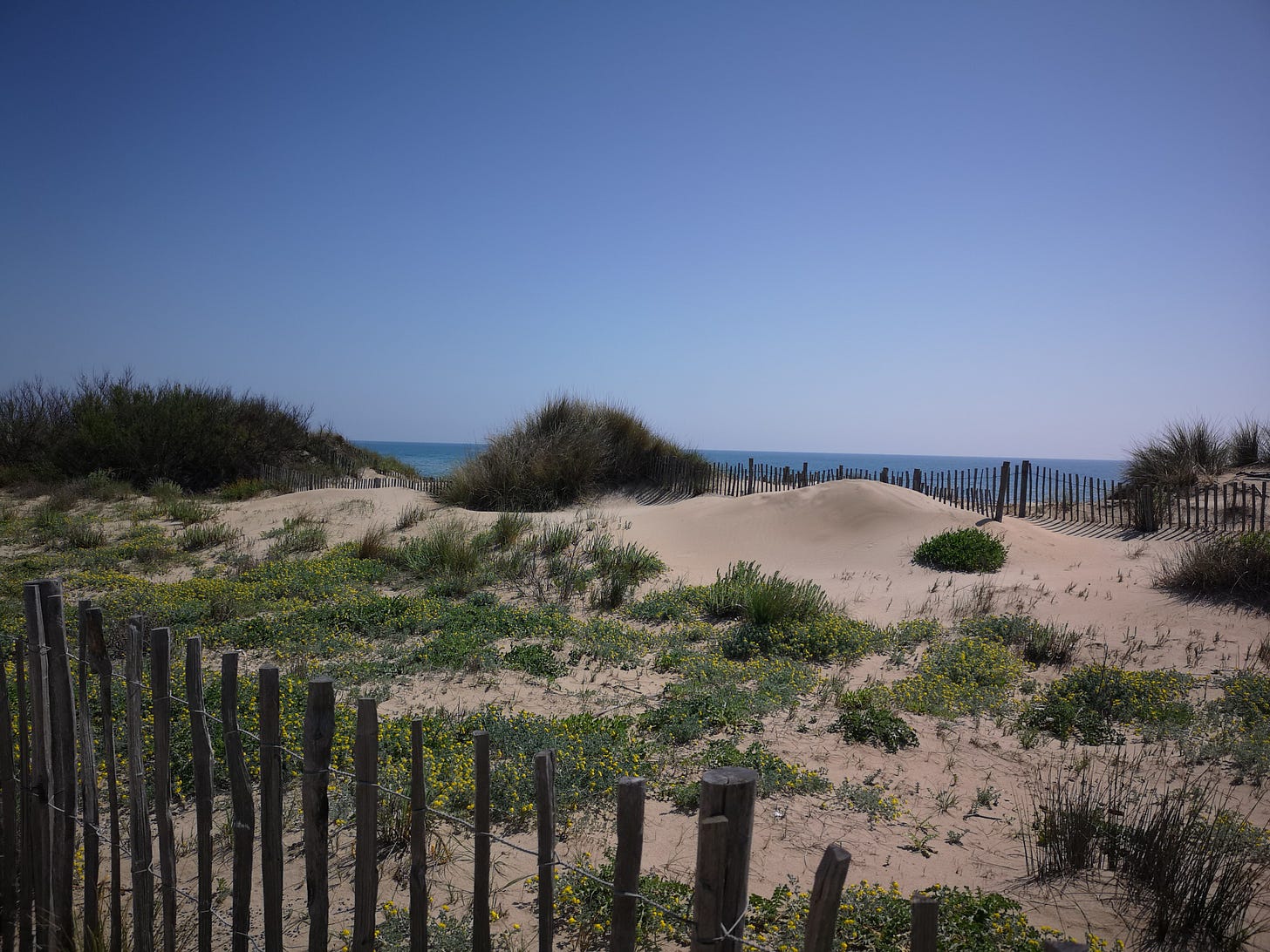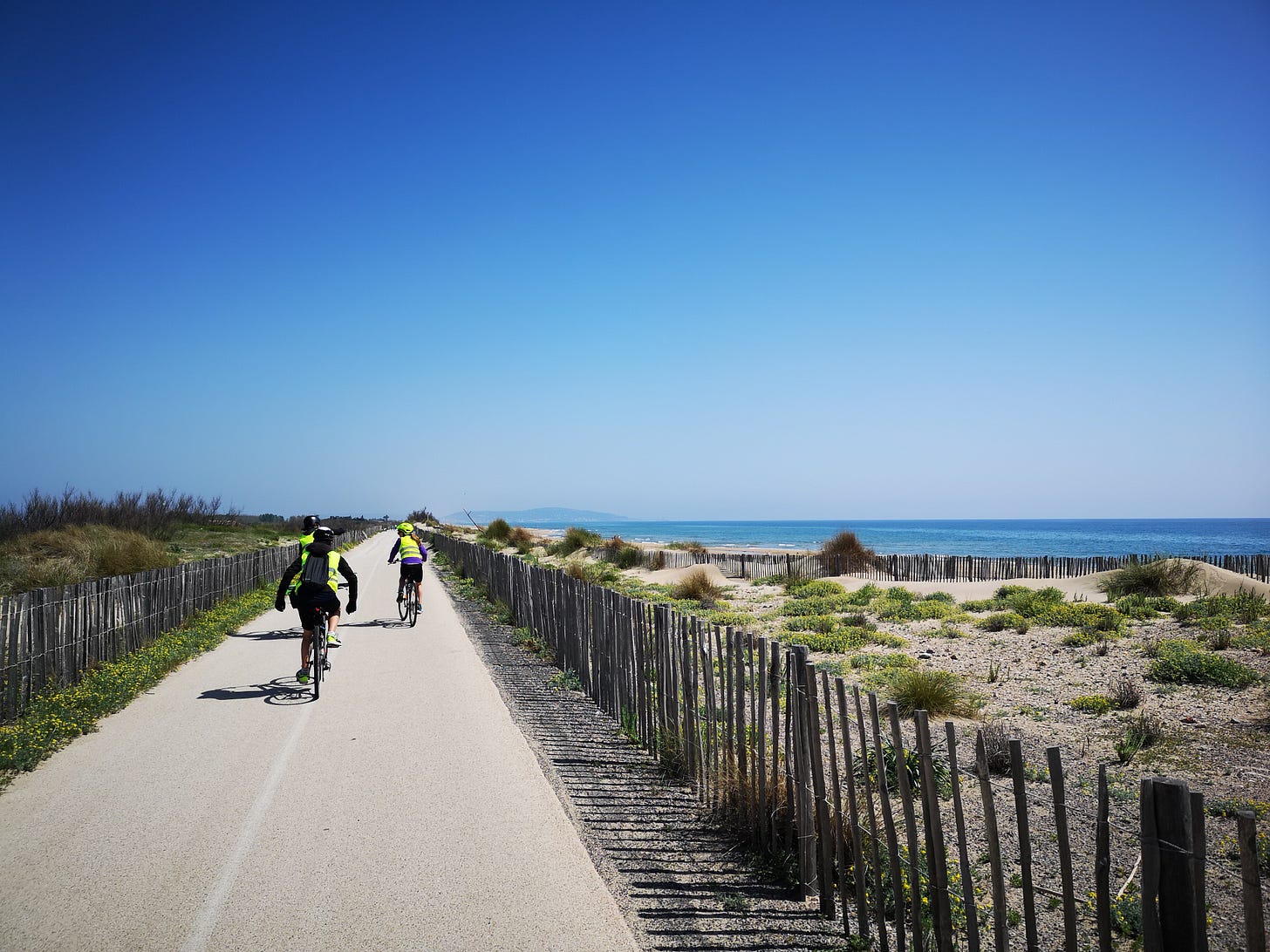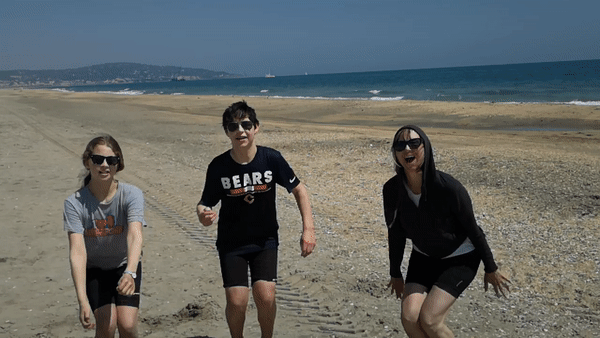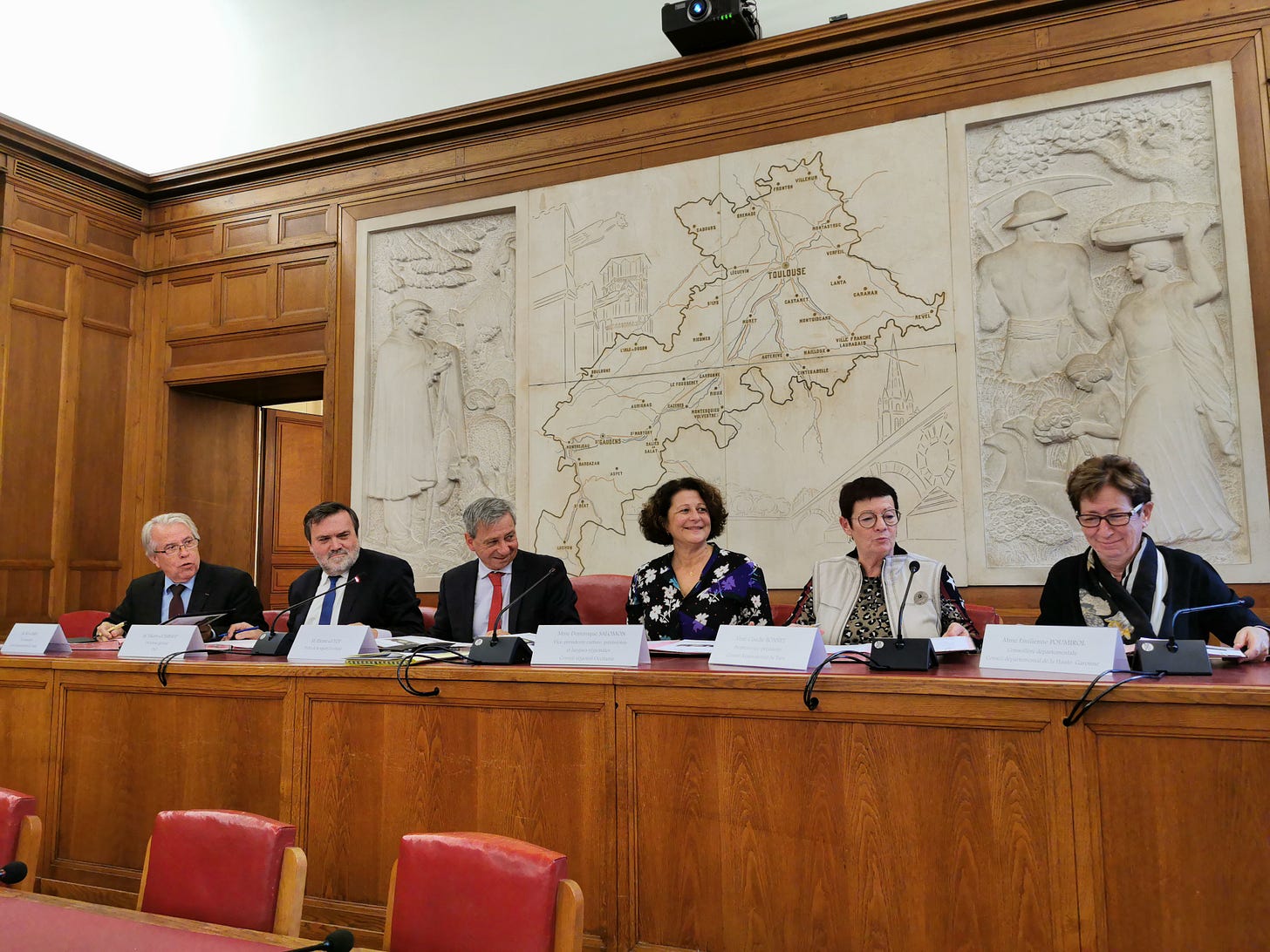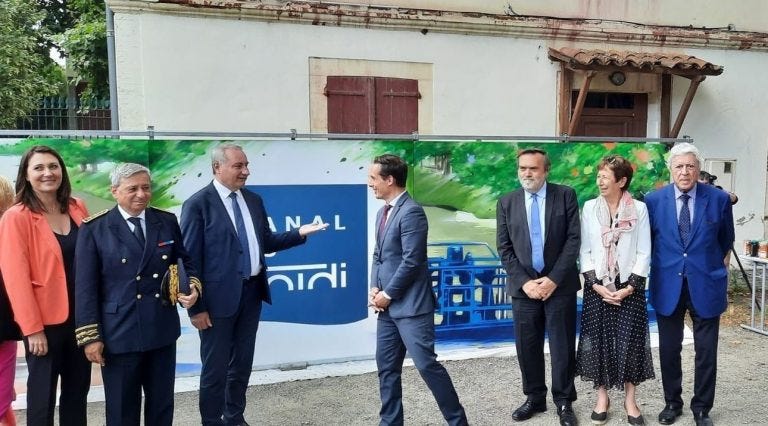Biking The Forgotten Canal Du Midi: Day 5
The region gets serious about the canal's future.
Read Day 1, Day 2, Day 3, and Day 4.
For Day 5, we had a 28-mile route from Villeneuve-lès-Béziers to Sète, our final destination along the Mediterranean Sea. The path along almost the entire route was paved, making for gentle riding under the rows of trees that offered plentiful shade.
There was a short stretch where we had been advised to divert from the canal and take local roads. But this was behind us quickly as we soon were back along the canal. We passed a long stretch of the amusement park-like family camps the French prefer over backpacking, and then an actual, gaudy amusement park as well as a bizarre cluster of haunted-house-horror-themed parks.

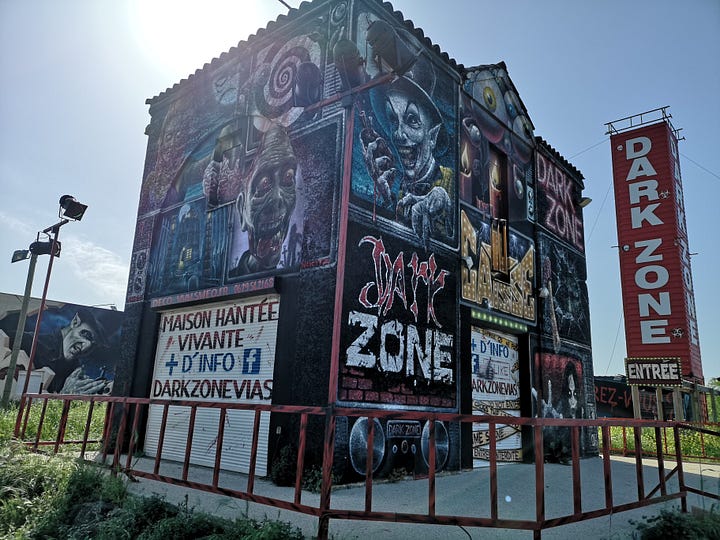
The rural ambiance was slipping away now as we crossed the Hérault River and entered the town of Agde. We skirted around the exterior and then made a tough decision.
From here, the canal turned north for several more kilometers before reaching its final destination, the Étang de Thau. This “pond” is separated from the Mediterranean by a long peninsula that leads to Sète, the ancient entry point for ships carrying cargo destined for the canal. But another local road from Agde had a dedicated bike lane and a more direct route to the sea. Hard as it was to not pursue the psychological victory of seeing the official end of the canal, the ease offered by the bike lane was too alluring after 5 days glued to bike seats.
These last 15 miles flew by us in what felt like a blink. When we reached Marseillan Beach along the Sète peninsula, the bike path separated from the road and widened into two dedicated, spacious bike lanes that allowed us to ride abreast of each other. From this point to Sète, there is a stretch of remarkably undeveloped beach for about 8.5 miles until the end of the peninsula that has since become one of our favorite French coastal spots.
On either side were protective sand dunes with wisps of grass as anchors. The sun was bright, and the blue Mediterranean sparkled under it.
We were giddy now, clapping our hands and cheering ourselves. About halfway down the peninsula, we stopped one last time and locked the bikes for a short picnic on the sand. Slipping off our shoes, we waded into the chilly waters up to our ankles, took selfies, saluted Riquet’s grand work, and celebrated our accomplishment.
The Path Ahead
These images of triumph were revived 18 months later when I received an email from the regional Occitanie government inviting me to a press conference concerning the future of the Canal du Midi.
The November 2019 event was being held at the Toulouse prefecture, a 5-minute walk from my front door. Entering the main courtyard, I passed under an imposing portal with 50-foot doors swung open into the courtyard. The building dates to the 17th century when it was home to religious leaders before being seized in the Revolution and repurposed for administrative functions.
A press officer led me and two local French reporters into the press conference. Given the subject, I was surprised that it had attracted so little attention from the local media. We were taken into a vast chamber where about 50 local officials were seated around wooden tables and banks, with six administrators presiding over the group from a raised table in front.
The convener of the meeting was Étienne Guyot, the prefect of the Occitanie region, someone who represents the national government in a territory while also being responsible for numerous administrative functions. Guyot was joined on either side by representatives of VNF, the regional Occitanie government, and three officials from departments whose territories were crossed by the canal (Haute Garonne, Aude, Hérault). They were gathered to sign a contract that detailed their goals for securing the canal’s future and creating a formal structure to carry out those plans.
This alliance planned to spend $144 million to restore the canal and promote it, including eventually building a real bike path that spans the entire canal from Toulouse to Sète. Plans also called for creating a coherent tourism strategy to promote the canal, including the development of a branding campaign that would unify efforts to communicate about the canal and draw more visitors while convincing tourists to visit sites and towns near the canal in regions that are some of the poorest in France. The contract also established an “observatory” to learn how many people visit the canal, where they come from, and why they come. While officials like to estimate 1.5 million people visit the canal each year, they really don’t know, and even less is known about their economic impact.
After the signing, I told Guyot that having ridden the canal I was pleased to hear about the ambitious plans. I also asked him why it had taken so long to rally around such a project whose needs must have seemed obvious for decades. He explained that in part it was the complexity of drawing together so many players with different interests.
But he also acknowledged that there had been a general lack of “awareness” in terms of how dilapidated this historic asset had become and the immense opportunity it could represent. Beyond the money and the goals, the contract was a symbol that officials across the region recognized their responsibility to restore the canal and to help it regain at least some of its past glory as well as to leverage its full tourism potential.
Realizing this vision remains a daunting task, but the motivation to act is at least a recognition of the collective responsibility to ensure a better future for this waterway. Laurent Cyrot, director of the Canal du Midi project for the Occitanie regional government, explained that the contract is really a broad statement of goals. Yet to come is the critical but often tedious bureaucratic details of how committees will be created to pursue things like a tourist plan and branding, who will sit on them, and the method they will use to create consensus.
As for the bike path, its future is also hopeful but fuzzy. The platanes had deep roots, and as they were removed, they left the banks of the canal unstable. As thousands more trees may need to be ripped out and then younger ones replanted, it’s hard to predict just when the land along the canal will be in any condition to support the construction of a bike path, Cyrot said.
For now, the mobilization was a start and a win. Unifying at long last all these groups to work toward a common goal was a breakthrough. Perspectives on time here are long. Whether it takes 5 or 10 years to create a bike path, ultimately it will seem like nothing compared to the 27 years it took Riquet to build the canal using rudimentary tools, or the three centuries it has endured.
“We can do more to develop the economy around the canal and its magnificent works that are 350 years old,” Cyort said. “The idea is to see finally how we can attract people who live nearby as well as international visitors. We want to know how we can make them come and discover the canal.”
Flash Forward 5 Years
The best-laid plans, yada, yada, yada…
Four months after that meeting, a pandemic swept the globe and France went into national lockdown for 2 months. As in so many other aspects of life, Covid played havoc with timetables for the Canal project. But work continued to advance.
In July 2021, the Canal consortium officially unveiled at a ceremony with local leaders the first “Canal du Midi” brand including a logo and publicity campaign that sought to place the canal in the context of the great global wonders such as the Pyramids in Egypt.
They also introduced an early version of the first official website for the canal. A more complete site was rolled out last month. The site highlights the various cultural and historic sites along or adjacent to the canal.
Perhaps just as important, work is advancing on building a more robust and stable bike path. At a ceremony a few weeks ago, the Aude department (home of Carcassonne and the bulk of our Day 2 and 3 rides) announced that work had been completed on 25km of bike paths, including mixtures of pavement and reinforced packed gravel and official signage.


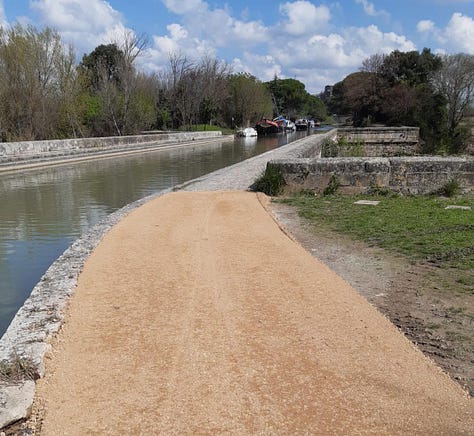
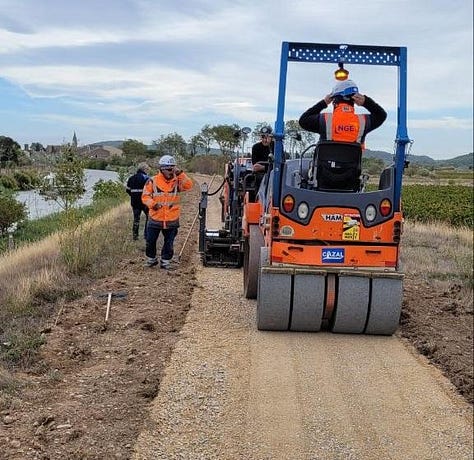


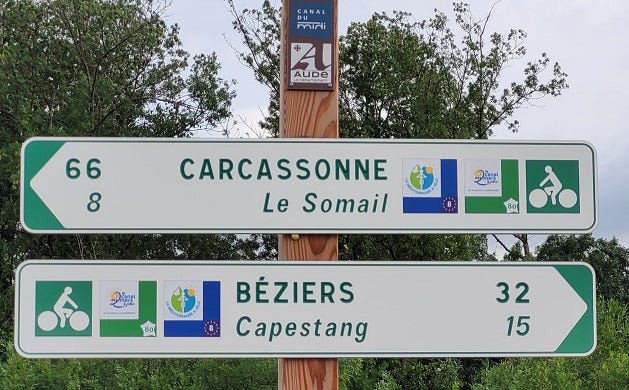

This is a great start, but just a start. Back in February, the group that had gathered in Toulouse back in 2019 reconvened a larger group to sign a new 5-year cooperation agreement which included more funds for building out the bike path and consultations on how to further develop the tourism strategy.
That tourism work includes creating committees that are identifying sites along the canal where interesting history occurred or are noteworthy for cultural reasons. Eventually, they will places signs and plaques along the route to tell those stories to visitors.
Following all of this progress is heartening. And it’s almost enough to convince me that maybe in the next couple of years, we should do our trip again on the New And Improved Canal du Midi bike path.
Chris O’Brien
Le Pecq


